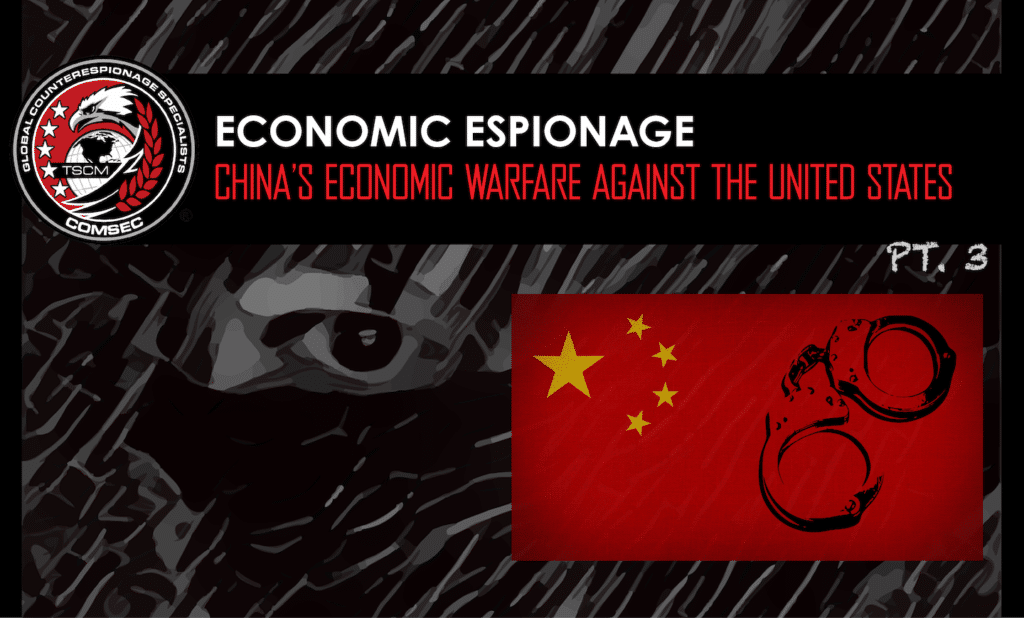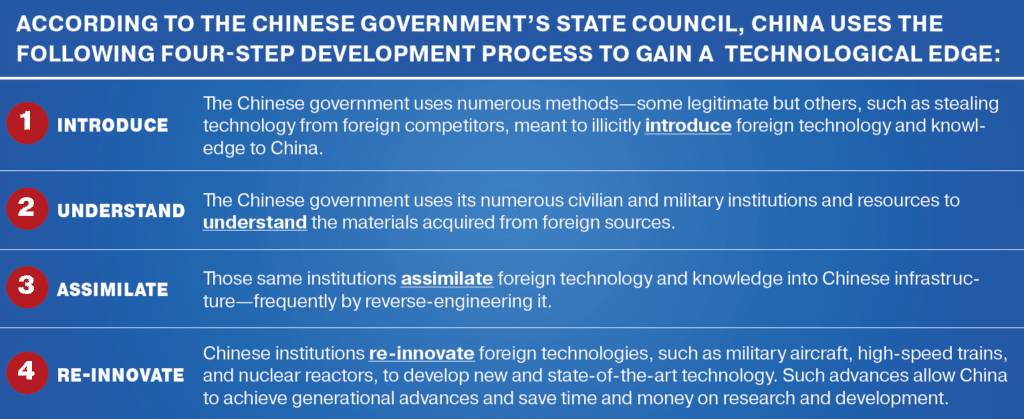This is the third blog in a multi-part series that examines the economic warfare China has been, and continues, to wage against the United States. In this blog series, we examine who the adversary is, US and China trade history & immigration policy and China’s national initiatives. We will also review recently prosecuted cases of China’s Intellectual Property (IP) and trade secret theft from the US military, US defense contractors, US businesses and US universities. As well, we will examine the tactics China used/uses to perpetrate these massive thefts from the US. Our ultimate goal is to provide information that can be used by US targets of Chinese Economic Espionage exploits to better protect their valuable intellectual property and trade secrets for their benefit, and for the benefit of the US. Read Part 1 and Part 2.
Part 3: Economic Espionage – China National Initiatives
In Part 1, we examined who China is as a country in comparison with the United States. We presented an extensive amount of information and statics for key markers. In Part 2, we looked at the lengthy, tumultuous and often retaliatory trade and immigration history of China and the United States, and where that relationship stands today. In Part 3, we are taking a look at China National Initiatives as they relate to Economic Warfare Against the United States. We will focus on three of the primary initiatives in this post: 1) Made in China 2025 (MiC 2025), 2) National High-end Foreign Expert Recruitment Plan (the antecedent of Thousand Talents) and 3) the Belt and Road Initiative (BRI).
As you review the post, please keep in mind that China (aka the People’s Republic of China) is run by the Chinese Communist Party (CCP). The nation is effectively a one party state because the CCP has such a dominant role. There are eight other minor parties that have a limited role on a national level. China is also a socialist nation. And, it is the world’s most populated nation with a population of over 1.41 billion (in 2021). China’s land mass is 3.7 million square miles. And, the population density in China is 153 per Km2 (397 people per mi2).
In contrast, the US is a federal republic with 50 states. The US has two major political parties Democratic and Republican. In 2021, the US population was 331.4 million. The US land mass is 3.6 million square miles, or about 2.1% less than China. However, if all American island territories are included in the figures, the US occupies a total area of about 3.8 million square miles. The population density in US is approximately 36 per Km2 (94 people per mi2).
Economic Espionage & Made in China 2025 (MiC 2025)
This 10-year, China state-led industrial initiative was issued by Premier Li in May 2015. The initiative is aimed at developing China to become dominant in global high-tech manufacturing. More specifically, the key targets of the Made in China 2025 initiative are to:
- Secure China’s position as a high-tech global powerhouse.
- Reduce China’s dependency on foreign technology imports, as well as to innovate so Chinese companies can compete both domestically and globally.
- Fully penetrate the global manufacturing chain, cooperate with industrialized countries and become more independent as a manufacturer.
- Move China from a low-cost manufacturer of components and finished products to a direct added-value competitor. (In other words, to evolve from a cheap source of manufactured components and finished goods to an innovative and quality oriented source.)
MiC 2025 identifies ten (10) industries of focus:
- New information technology (AI, IoT, smart appliances)
- Numerical control tools & robotics (AI, machine learning)
- Aviation and aerospace equipment (energy efficiency, electric vehicles)
- Marine engineering equipment and high-tech-ships
- Advanced railway equipment
- Energy efficient and green energy automobiles
- Power equipment
- Agriculture equipment
- New materials
- Biomedicine and high-performance medical instruments
Source: FBI: “China: The Risk to Corporate America”
And, China has historically employed a number of predatory tactics against foreign owned companies operating in China during the implementation of MiC 2025 , including1:
- Requiring government approval of foreign investment in China;
- Requiring foreign owned companies to have a Chinese partner, thus creating Joint Ventures;
- Using domestic standards, IP, competition, and procurement policies to force foreign know-how to be transferred to Chinese entities;
- Providing tax preferences to foreign firms who shift production and research and development (R&D) to China;
- Transferring foreign technology from these Joint Ventures to China so China develops capabilities;
- Providing government guidance funds (GGFs) to Chinese companies. Then, taking a stake or board seat in the GGF funded firms so they can influence corporate decision making;
- Targeting GGFs companies so the Chinese government can control foreign corporate expertise, IP, talent pools, suppliers and customers;
- China uses foreign technologies and equipment to fill key gaps in its current capabilities often licensing foreign technology, then stealing that technology;
- China actively recruits talent in key industrial sectors of interest; and
- China opens U.S. R&D centers that partner with universities and leverage U.S. talent.
The Made in Chine 2025 initiative has been criticized as relying “on discriminatory treatment of foreign investment, forced technology transfers, intellectual property theft, and cyber espionage.”2
In 2020, China instituted a new Foreign Investment law. The law creates a shift from the historical tactics to a Market Access Negatives List tactic. China’s Negative List includes both prohibited and restricted markets. This list includes 123 items including 5 prohibited items and 118 restricted items. However, China is now required to give national treatment to foreign investments that are not included on the Negative Lists. Also, Foreign Investment Entities receive equal treatment as domestic companies. And, there is no longer forced forfeiture of foreign intellectual property and some IP protections have been implemented for foreign investors. However, this is a small concession considering the extensive nature of China’s Negatives List.
We suggest you visit the following sites to learn more about the Made in China 2025 initiative:
- “Made in China 2025” Industrial Policies: Issues for Congress by Congressional Research Service.
- “Made in China 2025” Global Ambitions Built on Local Protections by the U.S. Chamber of Commerce.
- FBI: “China: The Risk to Corporate America“
Economic Espionage & China Talent Recruitment Plans:
China is operating more than 200 talent recruitment programs. The programs are intended to improve China’s economy, military and sci-tech innovation development at the expense of, and to the detriment of, foreign nations. The overall goal is to acquire/import proprietary technology, data, methods, and intellectual property . . . at low cost in comparison with the high cost of development. One of the more well known programs is the Thousand Talents Plan. In 2019, this program was replaced by the National High-end Foreign Expert Recruitment Plan. As part of the program(s), China is recruiting the following types of talent:
Scientists (younger than 55 years) from prestigious foreign universities, R&D organizations, international businesses and financial institutions who will live in China full time;
- Scientists with stable employers and clear work plans who either return/come to China for a minimum of two months each year for at least three consecutive years;
- Overseas entrepreneurs who hold mid to senior-level management positions in renowned international companies, who will come to China to start a business in one of China’s national strategic industries;
- Scientists (younger than 40) who have a Ph.D. degree (or Ph.D. students in some cases) from prestigious foreign universities, who will live in China on a full time basis;
- Foreign nationals (younger than 65) who will come to China to conduct research for a minimum of nine months a year for three consecutive years; and
- Foreign winners of major international awards and academicians of science/engineering educational institutions from select countries, who will live in China full-time for five years or more.
China’s talent recruitment programs often require the theft of foreign proprietary technology (e.g. trade secrets, data, methods, and intellectual property). When the talent is recruited from a US university, most often the “talent” receives compensation in the form of a US grant paid for by US tax payer dollars. The “talent” then becomes obligated to China and receives funding from China for the stolen technology while still receiving US grant funding. If the “talent” in successful in the theft of technology for China, the true cost of the theft is direct, indirect and future leaning. For universities, US financial losses include, but are not limited to: the US grant money invested in development of the technology, revenue that could have been derived directly from the stolen technology, revenue from future developments of that technology and loss of revenue/development of that know how when applied in other industries. In the private sector, the losses are similar and include, but are not limited to: shareholder/investor losses, jobs and tax revenue at the local, state and federal levels. As well, the losses are not only financial in nature. In the case of military technology, the theft can have national security implications. The true losses are actually exponential in the long term. China’s talent recruitment programs go far beyond economic espionage, but instead are best categorized as economic warfare.
We suggest you visit the following websites to learn more about China’s Talent Recruitment Plans:
- The CSET Chinese Talent Program Tracker catalog.
- U.S. Research Enterprise: China’s Talent Recruitment Plans report issued by United States Senate PERMANENT SUBCOMMITTEE ON INVESTIGATIONS Committee on Homeland Security and Governmental Affairs.
- FEDERAL BUREAU OF INVESTIGATION, COUNTERINTELLIGENCE DIVISION’s Public Service Announcement “Foreign Government-Sponsored Talent Recruitment Plans, such as “China’s Talent Plans, Incentivize Economic Espionage and Theft of Trade Secrets”
Economic Espionage & Infrastructure Development Initiatives:

- Association of South East Asian Nation (ASEAN) Connectivity initiative;
- Central Asia Regional Economic Cooperation (CAREC) Program;
- Greater Mekong Sub-Region (GMS) Cooperation Program;
- South Asia Sub-regional Economic Cooperation (SASEC) Program; and
- Belt and Road Initiative (BRI).
The Belt and Road initiative (BRI) is one of the more well known infrastructure plans. It’s referred to as “One Belt, One Road” in China. The initiative is a long term plan to connect Asia, Africa and Europe by land and maritime networks.
“The initiative defines five major priorities:
- policy coordination;
- infrastructure connectivity;
- unimpeded trade;
- financial integration;
- and connecting people.”3
The official China BRI policies total 46 as of the original date of this post. Currently, 71 countries are taking part in the BRI. These countries represent just over a third of the world’s gross domestic product and two thirds of the world’s population.3 However, the International Monetary Fund (IMF) has scrutinized multiple aspects of the BRI, repeatedly warning of unsustainable debt levels, predatory lending, and the lack of project transparency. 4
Some of the concerns with China’s BRI include:
- Loans issued are often at commercial interest rates (rather than a grant);
- Vital infrastructure funding for developing countries leaves them with unsustainable debt (most of that debt owed to China);
- Skyrocketing costs;
- Predatory lending practices (for instance, seizure of loan collateral);
- Locals in BRI countries have felt left out or overlooked as China views the BRI from a perspective of China’s benefit, and not the local nation(s); and
- China’s soft power influence is growing in such a large number of nations (BRI nations.)
US concerns over the BRI include, but are not limited to:
- The US will become less competitive in trade as compared to BRI nations (for example lower costs, BRI free trade agreements, etc.);
- The US will struggle to keep pace with China as Chinese firms rapidly gain market share and Chinese technical standards become the norm5;
- China’s is poised to dominate the blockchain networks which could impede the US’ ability to take cryptocurrency-related enforcement actions and even to prosecute those violating U.S. law related to certain cybercrimes;
- China’s digital renminbi, Digital Currency/Electronic Payment (DCEP), could replace its physical currency giving China real-time financial surveillance of users’ transactions and ultimately digital authoritarianism; and
- China’s influence in, control over and financial integration with BRI countries coupled with the unsustainable debt from the BRI assumed debt will rapidly expand China’s reach far beyond its physical borders.
We suggest you visit the following websites to learn more about China’s Infrastructure Development Initiatives:
- Asian Development Bank, Meeting Asia’s Infrastructure Needs.
- Center for Foreign Relations, Findings – China’s Belt and Road: Implications for the United States
- China Briefing, How Can Foreign Technology Investors Benefit from China’s New Infrastructure Plan?
- Barron’s, What America Can Learn from China about Infrastructure Investment
Key Take Aways from Economic Espionage: China’s Economic Warfare Against the United States Part 3: China National Initiatives:
- China has developed strategic long range plans to grow its economy and its influence in the world based on a common national vision;
- China will obtain what is needed (technology, talent, etc.) to achieve its national initiatives by any means, legal or illegal, including theft, illegal surveillance, etc.;
- China national initiates are designed in a way that not only increases its influence and power, but also destroys other nation’s influence so it inflicts much more harm; and
- China’s long range plans are to become the largest economic power in the world and maneuver to gain control over the world and the way in which it operates.
Sources:
1. “Made in China 2025” Industrial Policies: Issues for Congress by Congressional Research Service, https://crsreports.congress.gov/product/pdf/IF/IF10964
2. Council on Foreign Relations, “Is ‘Made in China 2025’ a Threat to Global Trade?”, https://www.cfr.org/backgrounder/made-china-2025-threat-global-trade
3. European Bank, :”Belt and Road Initiative (BRI)” https://www.ebrd.com/what-we-do/belt-and-road/overview.html
4. Center for Strategic and International Studies, “It’s a (Debt) Trap! Managing China-IMF Cooperation Across the Belt and Road”, https://www.csis.org/npfp/its-debt-trap-managing-china-imf-cooperation-across-belt-and-road
5. Council on Foreign Relations, “China’s Belt and Road: Implications for the United States”, https://www.cfr.org/report/chinas-belt-and-road-implications-for-the-united-states/findings
In the next blog in the series, we will review prosecuted cases of China’s Economic Espionage Against the US through Intellectual Property (IP) and trade secret theft from the US military, US defense contractors, US businesses and US universities.
Disclaimer: The People’s Republic of China, PRC, China and Chinese references in this blog are used to reference China as a country/government. No references herein should be construed as a reflection on the character or motives of individual Chinese/PRC citizens, US Chinese immigrants or Chinese foreign nationals.
About the Author:
J.D. LeaSure, CCISM, is the President / CEO of ComSec LLC, a global provider of world class counterespionage and TSCM / Cyber TSCM™ services. www.ComSecLLc.com
Coauthored by Lisa LeaSure, Director of Operations, ComSec LLC.




 Scientists (younger than 55 years) from prestigious foreign universities, R&D organizations, international businesses and financial institutions who will live in China full time;
Scientists (younger than 55 years) from prestigious foreign universities, R&D organizations, international businesses and financial institutions who will live in China full time;